Benefits Of Using Left & Right Hand Circular Polarised Antennas In Mines & Tunnels
Introduction
POYNTING offer a range of underground/tunnel antennas, namely the HELI and miniHELI series. Branded as MinePoynt antennas, these antennas are suited for various types of tunnels, including mining, tunnelling, automotive tunnels, shipping tunnels, etc. These antennas offer solutions where the next level of ‘Industrial’ grade communication system is required, to offer more reliable and more stable networks for safety purposes, telemetry, automation or just general communications underground.
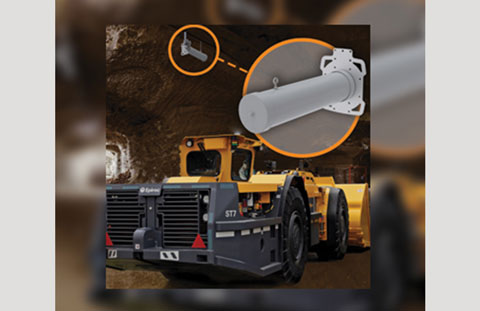
Why Circular Polarisation for tunnels?
When using ‘normal’ linear antennas in open air environments, it is important to have the transmit and receive antennas fully aligned to achieve the maximum signal transfer – I.e. both antennas should either be vertically aligned or horizontally aligned. When a linear antenna is used in a tunnel (the red wave in the example), this causes the RF wave to be reflected from the non-linear (rounded/angular) surfaces, resulting in the signal to rotate unpredictably down a tunnel. The received wave (the green wave in the example) is likely to be received at the wrong polarisation, reducing the efficiency of the system.
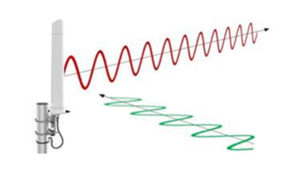
Why Circular Polarisation for tunnels?
When using ‘normal’ linear antennas in open air environments, it is important to have the transmit and receive antennas fully aligned to achieve the maximum signal transfer – I.e. both antennas should either be vertically aligned or horizontally aligned. When a linear antenna is used in a tunnel (the red wave in the example), this causes the RF wave to be reflected from the non-linear (rounded/angular) surfaces, resulting in the signal to rotate unpredictably down a tunnel. The received wave (the green wave in the example) is likely to be received at the wrong polarisation, reducing the efficiency of the system.

Left Hand and Right Hand Circular polarisation for MIMO deployments
For circular polarised antennas, when the electric field rotates clockwise or anti-clockwise then we call it a right-hand/left-hand circular polarised (RHC & LHC), respectively. Interesting to note; when a circular polarised wave reflects off a surface, the polarisation of the wave changes from LHC to RHC or vice versa – similar to a mirror image.
When using a circular polarised antennas in tunnel communications systems, e.g. with an Access Point (AP) or Mesh Node, it will receive a combination of LHC & RHC reflected signals. To enhance the RF link performance for mission critical Industrial Internet of Things (IIoT) networks, it is advised to deploy both LHC and RHC antennas to benefit from the various mirrored waves.
Some of our MinePoynt and MiniHELI antennas are available in both LHC and RHC polarisation for dual-band Wi-Fi, Wi-Fi-6 (802.11ax), LTE & 5G cellular applications. The benefit of using both RHC & LHC polarised antennas with a MIMO Access Point (AP) or Mesh Node is that it provides better decorrelation between the various propagated signals, resulting in better diversity and MIMO performance in these difficult RF environments. It will result in an improvement in reception quality and data throughput. Making use of both LHC and RHC polarised antennas with ‘Beam Forming’ routers also enhances the router’s signal mixing/combining processes from the different received signal streams, especially routers that dynamically assign packets to all the streams independently.
For Single Input Single Output (SISO) applications it is necessary to use only one of the polarisations, so which one needs to be chosen? In straight commercial tunnels where the signal is propagated with Line of Sight (LoS), such as car and train tunnels, it is necessary to match the circular polarised antennas, i.e. RHC must be used with a RHC antenna or vice versa (LHC with a LHC antenna).
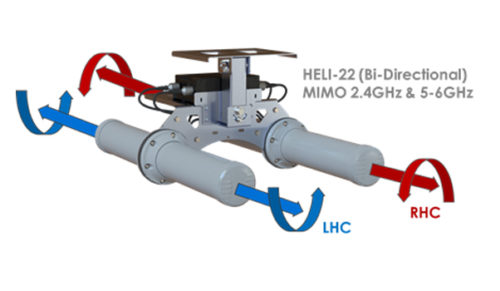
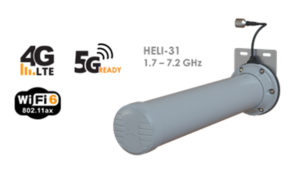
For the antenna ranges where we have both LHC and RHC polarising offered, and a customer places an quotation without specifying the polarisation, we prefer our customers to choose LHC as the default choice, only from a stockholding perspective – we will keep more LHC antennas than RHC ones.
In non-LoS scenarios, such as mine tunnels, cavities, stopes, etc., it is not necessary to match the polarisation, so the LHC antenna can be used on the one end of the link and a RHC on the other end of the link. However, making use of both LHC & RHC together in a MIMO configuration will always be the better option.
POYNTING’s MinePoynt (HELI and miniHELI) range of antennas for mines and tunnels
POYNTING Antennas offers a whole range of circular polarised antennas known as our MinePoynt antennas, consisting of our HELI and miniHELI antennas. The latest addition to the range is the HELI-21 and HELI-22 dual-band MIMO antennas, which operate in the 2.4 GHz and 5 GHz Wi-Fi frequency bands. The HELI-21 antenna is a circular polarised uni-directional antenna, while the HELI-22 is a circular polarised bi-directional antenna. The bi-directional HELI-22 antenna is an excellent choice for coverage of longer tunnels, where a single set of MIMO antennas are capable of covering both up and down the same tunnel without consuming additional radio ports in each direction.
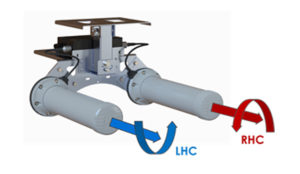
These antennas offer ‘multi-dimensional’ diversity as they provide:
- Spatial Diversity (the MIMO antennas are physically separated) – which helps reduce RF fading ‘dead spots’, which are often experienced after implementation of normal underground wireless networks.
- Frequency Diversity (using both 2.4 & 5 GHz) – which further reduces ‘dead spots’ as a result of the different wavelength, adding a new dimension to the diversity aspects of the system.
- Polarisation Decorrelation as a result of the RHC & LHC polarisation. In the circular polarisation terms has similar effect as cross polarised linear antennas in extra-terrestrial environments, but significantly more suitable for tunnel environments.
Our miniHELI range of antennas that are available to implement the above-mentioned methods of communication are given below:
| Commercial Name | Antenna Description (all antennas are LH/RH Circular Polarised) |
| HELI-0011 | Uni-Directional Mine/Tunnel Antenna; Wi-Fi 2400 – 2500 MHz, 12 dBi |
| HELI-0012 | Uni-Directional Mine/Tunnel Antenna; Wi-Fi 5000 – 6000 MHz, 13 dBi |
| HELI-0013 | Uni-Directional Mine/Tunnel Antenna; Dual-band Wi-Fi, 2400 – 2500 MHz, 12 dBi; 5000 – 6000 MHz, 13 dBi |
| HELI-0017 | Bi-Directional Mine/Tunnel Antenna; Wi-Fi 2400 – 2500 MHz, 9 dBi |
| HELI-0018 | Bi-Directional Mine/Tunnel Antenna; Wi-Fi 5000 – 6000 MHz, 11 dBi |
| HELI-0019 | Bi-Directional Mine/Tunnel Antenna; Dual-band Wi-Fi 2400 – 2500 MHz, 9dBi; 5000 – 6000 MHz, 11 dBi |
| HELI-0021 | Uni-Directional Mine/Tunnel Antenna; Dual-band Wi-Fi 2400 – 2500 MHz, 12 dBi; 5000 – 6000 MHz, 13 dBi |
| HELI-0022 | Bi-Directional Mine/Tunnel Antenna; Dual-band Wi-Fi 2400 – 2500 MHz, 9dBi; 5000 – 6000 MHz, 11 dBi |
| HELI-0031 | Uni-Directional Mine/Tunnel Antenna; LTE/5G/Wi-Fi-6, 1700 – 7200 MHz, 9dBi |
We also have a range of traditional high performance 2.4 GHz Circular Polarised Wi-Fi antennas:
| Commercial Name | Antenna Description |
| HELI-0003 | Circular Polarised, Directional Mine/Tunnel Antenna; Wi-Fi; 2400 – 2500 MHz, 18.5 dBi |
| HELI-0004 | Circular Polarised, Directional Mine/Tunnel Antenna; Wi-Fi; 2400 – 2500 MHz, 15.5 dBi |
| HELI-0005 | Circular Polarised, Directional Mine/Tunnel Antenna; LTE; 1710 – 2170 MHz, 16 dBi |
| HELI-0006 | Circular Polarised, Directional Mine/Tunnel Antenna; LTE/LoRa; 690 – 960 MHz, 13 dBi |
| HELI-0008 | Circular Polarised, Bi-Directional Mine/Tunnel Antenna; Wi-Fi; 2400 – 2500 MHz, 14dBi |

